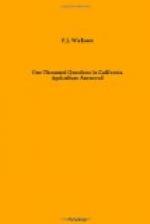Butter-fat is the yellow substance which forms the larger part of butter. Besides, this fat butter is composed of 16 per cent or less of water and small amounts of salt, and other substances of which milk is composed. From 80 to 85 per cent or so of ordinary butter is the fat itself. It is sold by weight. The cream from which butter is made is taken to the creamery and weighed, not measured. A small sample is tested by the so-called Babcock test to determine the exact percentage of fat, and payment mode on this basis. For instance, if 1,00 pounds of cream is one-third butter-fat, the dairyman receives pay for 33 1/3 pounds of this substance. If it is only one-quarter fat, he receives pay for 25 pounds. Ordinary cream varies within these limits, but may be much richer or thinner. Cream after the butterfat is removed is much like skimmed milk, although it has less water in it.
Why Would Not Butter Come?
What is the trouble with cream that you churn on from Monday until Saturday, then have to give up in despair and turn it out to the hogs? We warmed it, and we cooled it, and used a dairy thermometer, but nothing would do.
If the cream was in churnable condition otherwise, the probability is that it was too cool when you started churning. It should be about 62° Fahrenheit.
Drying a Persistent Milker.
My cow is to come fresh about the middle of next mouth, and in the last two weeks her milk has changed in some way so that the cream makes very yellow butter and comes to butter nearly as quick as when the cow was fresh. Would it best for her to go entirely dry before coming fresh, or will it be all right if she does not entirely dry up?
If your cow has been able to pick up any special amount of grass since the rains came it might add to the color of the butter. A cow’s milk also gets richer toward the end of her lactation period, which may make a richer cream and make the butter come quickly There does not seem to be anything to worry about. The cow would probably do better if she could become entirely dry before calving, but unless you can easily dry her up it would be dangerous to try to force her to do so.
Butter-fat in Sweet and Sour Cream.
The creamery wagon takes our cream every other day. Without ice it is almost impossible to keep the cream sweet during the hot weather. By the time the wagon gets here, several hours after the fourth milking, the cream is quite sour. Does sour cream test lower than sweet cream! Is any butter-fat lost due to evaporation in dry weather?
The test of sour cream will be as accurate as of sweet cream, if properly made, but it is rather more difficult to make; or rather, to get the material into condition to work well. There is no fat lost by evaporation.
Cream That Won’t Whip.
When I sell my cream from the separator they say they
cannot whip it.
Can you tell me if there is any way that I can make
the cream whip?




